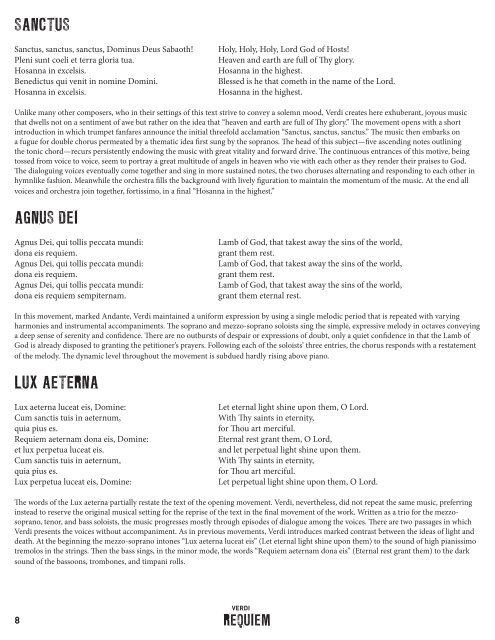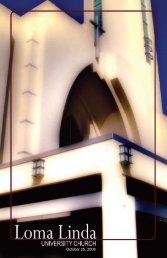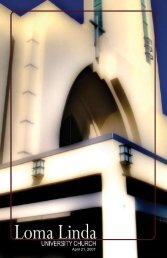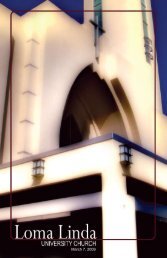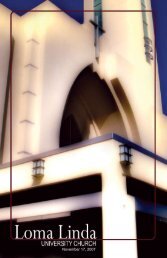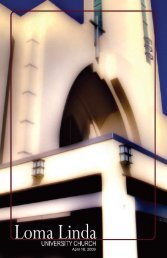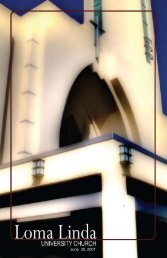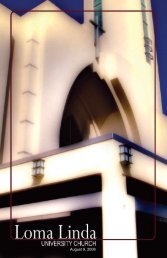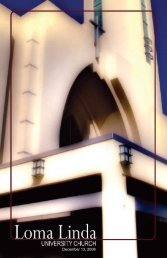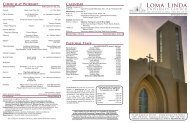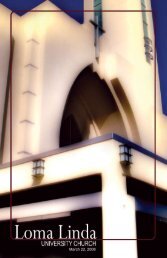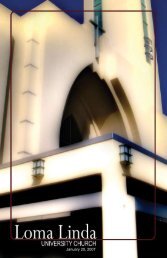LLUC Verdi Requiem Concert Program - Loma Linda University ...
LLUC Verdi Requiem Concert Program - Loma Linda University ...
LLUC Verdi Requiem Concert Program - Loma Linda University ...
- No tags were found...
Create successful ePaper yourself
Turn your PDF publications into a flip-book with our unique Google optimized e-Paper software.
SANCTUS<br />
Sanctus, sanctus, sanctus, Dominus Deus Sabaoth!<br />
Pleni sunt coeli et terra gloria tua.<br />
Hosanna in excelsis.<br />
Benedictus qui venit in nomine Domini.<br />
Hosanna in excelsis.<br />
Holy, Holy, Holy, Lord God of Hosts!<br />
Heaven and earth are full of Thy glory.<br />
Hosanna in the highest.<br />
Blessed is he that cometh in the name of the Lord.<br />
Hosanna in the highest.<br />
Unlike many other composers, who in their settings of this text strive to convey a solemn mood, <strong>Verdi</strong> creates here exhuberant, joyous music<br />
that dwells not on a sentiment of awe but rather on the idea that “heaven and earth are full of Thy glory.” The movement opens with a short<br />
introduction in which trumpet fanfares announce the initial threefold acclamation “Sanctus, sanctus, sanctus.” The music then embarks on<br />
a fugue for double chorus permeated by a thematic idea first sung by the sopranos. The head of this subject—five ascending notes outlining<br />
the tonic chord—recurs persistently endowing the music with great vitality and forward drive. The continuous entrances of this motive, being<br />
tossed from voice to voice, seem to portray a great multitude of angels in heaven who vie with each other as they render their praises to God.<br />
The dialoguing voices eventually come together and sing in more sustained notes, the two choruses alternating and responding to each other in<br />
hymnlike fashion. Meanwhile the orchestra fills the background with lively figuration to maintain the momentum of the music. At the end all<br />
voices and orchestra join together, fortissimo, in a final “Hosanna in the highest.”<br />
AGNUS DEI<br />
Agnus Dei, qui tollis peccata mundi:<br />
dona eis requiem.<br />
Agnus Dei, qui tollis peccata mundi:<br />
dona eis requiem.<br />
Agnus Dei, qui tollis peccata mundi:<br />
dona eis requiem sempiternam.<br />
Lamb of God, that takest away the sins of the world,<br />
grant them rest.<br />
Lamb of God, that takest away the sins of the world,<br />
grant them rest.<br />
Lamb of God, that takest away the sins of the world,<br />
grant them eternal rest.<br />
In this movement, marked Andante, <strong>Verdi</strong> maintained a uniform expression by using a single melodic period that is repeated with varying<br />
harmonies and instrumental accompaniments. The soprano and mezzo-soprano soloists sing the simple, expressive melody in octaves conveying<br />
a deep sense of serenity and confidence. There are no outbursts of despair or expressions of doubt, only a quiet confidence in that the Lamb of<br />
God is already disposed to granting the petitioner’s prayers. Following each of the soloists’ three entries, the chorus responds with a restatement<br />
of the melody. The dynamic level throughout the movement is subdued hardly rising above piano.<br />
LUX AETERNA<br />
Lux aeterna luceat eis, Domine:<br />
Cum sanctis tuis in aeternum,<br />
quia pius es.<br />
<strong>Requiem</strong> aeternam dona eis, Domine:<br />
et lux perpetua luceat eis.<br />
Cum sanctis tuis in aeternum,<br />
quia pius es.<br />
Lux perpetua luceat eis, Domine:<br />
Let eternal light shine upon them, O Lord.<br />
With Thy saints in eternity,<br />
for Thou art merciful.<br />
Eternal rest grant them, O Lord,<br />
and let perpetual light shine upon them.<br />
With Thy saints in eternity,<br />
for Thou art merciful.<br />
Let perpetual light shine upon them, O Lord.<br />
The words of the Lux aeterna partially restate the text of the opening movement. <strong>Verdi</strong>, nevertheless, did not repeat the same music, preferring<br />
instead to reserve the original musical setting for the reprise of the text in the final movement of the work. Written as a trio for the mezzosoprano,<br />
tenor, and bass soloists, the music progresses mostly through episodes of dialogue among the voices. There are two passages in which<br />
<strong>Verdi</strong> presents the voices without accompaniment. As in previous movements, <strong>Verdi</strong> introduces marked contrast between the ideas of light and<br />
death. At the beginning the mezzo-soprano intones “Lux aeterna luceat eis” (Let eternal light shine upon them) to the sound of high pianissimo<br />
tremolos in the strings. Then the bass sings, in the minor mode, the words “<strong>Requiem</strong> aeternam dona eis” (Eternal rest grant them) to the dark<br />
sound of the bassoons, trombones, and timpani rolls.<br />
8<br />
VERDI<br />
REQUIEM


